The Token End of Year Post 2015
For the sixth year running I must, once again, confess that I’ve yet to watch a single episode of Gundam Unicorn. This is particularly bad at this point, because I’ve actually some how managed to get around to seeing the first couple of episodes of Gundam the Origin this year, not to mention being fully up-to-date on Iron Blooded Orphans.
Seriously, I’ll totally crack open those BDs this year.
Anyway, here’s too many words to be actually worth reading about some cartoons from this year. Spoilers be lurking thar below!
The “Where has All My Money Gone†Award for Wallet Emptying Merchandise – THE iDOLM@STER
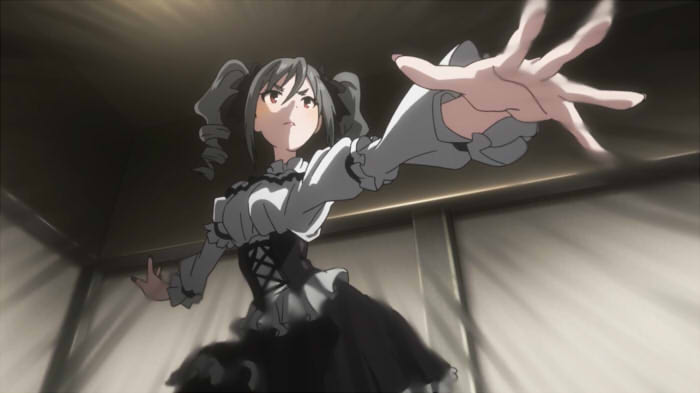
I probably didn’t spend as much on iM@S-related matters this year as in recent years prior. Maybe. I think. Actually, that’s probably not entirely true. Or even slightly true, now that I look at the line of Cinderella Girls BDs sitting on my shelf. That’s the danger of idol cartoons, I suppose.
This is the year of Cinderella Girls though, I guess. There’s nothing like an anime production to break down those barriers you’ve constructed to prevent yourself from going bankrupt, although it is starting to feel like maybe Aquors are the harbingers of the downfall of idol anime. Every trend has to break at some point, after all.
Honestly, a lot of where I’m at with idol anime at these days is enjoying them from a meta point of view. I don’t really mean entirely in the 2.5D sense that a lot of folks I know are increasingly enjoying these things – I’m certainly not adverse to watching lives or anything (I have the Star*Anis BD sitting around here to be watched later), but I do continue find the whole VA fandom thing curiously impenetrable – but rather in the way they go about constructing these things, and the strings they are pulling. Most of the big idol cartoons which have been made are very different in the way they go about being an actual cartoon.
The funny thing about Cinderella Girls is that, despite the previous 765Pro show and the overlap in the staff between the two, it’s a pretty different feeling show. I tend to throw the word “cartoon” around when talking about anime a lot, but that’s a big part of the key difference – it’s probably not an accident that a lot of the CDs for the 765Pro iM@S show rather explicitly use the English word “Cartoon” to describe the series. In contrast, Cinderella Girls very much cuts down on the deliberately wacky – you aren’t going to get an episode involving prop-fu fights against gangsters, or getting pimp-slapped by a sassy hamster in Cinderella Girls.
This isn’t to say that Cinderella Girls isn’t comedic, but it does make efforts to at least stay somewhat grounded. It’s curious as a contrast, as whilst I’d struggle to necessarily call the 765Pro AllStars normal, they’re a far-cry from the excesses of the Cinderella Girls barrel bottom. The Cinderella Girls are a necessity of the nature of mobile games, really – if you make yourself a game with dozens of characters in a competitive market, you need to start throwing in wacky concepts both to differentiate your characters from each-other, and to try and get something to actually stick with the player during that initial on-boarding period.
That’s one of the impressive things about the approach in the Cinderella Girls anime, though – that it attempts to take characters like Anzu, Miku, Nana or Sachiko and endeavours to put some kind of grounding to them. There’s something to be said about taking something as silly as an idol who claims to be a rabbit-eared alien and managing to craft a somewhat poignant story about identity issues around it, even before you start to look at the fascinating meta about how that applies to characters who are entirely fictional constructs.
Cinderella Girls as a show is entirely about those kinds of contrasts, though. Whilst they didn’t initially seem like the most obvious of groupings, particularly given what had come in the official franchise materials beforehand, most of the Cinderella Project Units were meticulously put together to explicitly contrast differences in character traits. Dekoration exists to explore themes of maturity, Asterisk is all about investment, Candy Island is about natural talent versus expending effort and so on.
Ultimately, even the eventual series-end drama boils down to a contrast in approach. Neither Producer nor Director Mishiro are necessarily wrong in their approach, even if one is made easier to cheer on, but they’re both approaching things from opposite extremes – Producer believes allowing the girls the time they need to find their own way, whilst Mishiro believes in aggressively managing things to maximise the results. On a meta level, it probably says something about what happens when corporate interests eventually have to entrench upon something that’s largely only been loosely defined in the hands of fans previously (like, say, when they make an anime out of a mobile phone idol game), but that’s a whole other discussion.
(Also, don’t mention 10th to me. It’ll probably continue to be something of a pretty sore point for years to come…)
(Also Also, speaking of lives, Lantis Vegas was pretty fun, yo. Kind of a shame Lantis’s idea of having a world tour only really extended to places around the Pacific Rim, but ho-hum, what you going to do?)
(Also Also Also, I hope the change in venue again still allows Hyper Japan to run it’s live stage again this year. Last years event feels like it’s been the first one a trip to has actually been worthwhile)
(Also Also Also Also, I doubt many were expecting Minami to come out of the show as popular as she ended up, at least not after the first couple of episodes)
(Also Also Also Also Also, it was nice that the show gave me a pretty good reason to go back and evaluate a bunch of CDs I already owned. It was pretty great watching the third episode and suddenly realising I already had Tokimeki Escalate sitting in my cupboard)
The “What was that about again” Award for Least Achieving What It Most Needed To – Kantai Collection

Speaking of corporate interests trying to define something!
I’ve not actually written a whole lot about anything this year, to be honest, but I guess I got the closest to writing something about every episode of Kancolle – I only missed writing about the last episode, after all.
I think I probably said this pretty early on, but the struggle with the KanColle anime was always going to be that the original work, even compared to something like deremas, is so astonishingly loose – outside of character traits, there almost feel like there was an active effort to not specifically define a lot of the elements of the universe, leading to there being almost as many interpretations of the property as there were people writing works set in it. Attempting to make a canonical anime out of such a thing is effectively endeavouring to define what that thing is going to be going forward.
That the KanColle anime didn’t really alter the direction of KanColle fandom more than perhaps one or two iota’s probably speaks volumes to how successful it was as a show. Even as it was airing, anything the show was actually doing was been massively eclipsed by things being introduced in the game, and that’s continued to be the case going forward.
Not that I particularly think that KanColle was a terrible show or anything, but it didn’t really pivot hard enough in any direction to really work. I mean, I’m sure that if every episode had just been the Kongou sisters trying to track down Shimakaze, or the curry cook-off, the audience would have been more than happy. Instead, the show attempted to tread the path of the happy medium of jumping between the comedy and the serious, but the show just wasn’t interested enough in actually defining it’s own lore to actually do anything worthwhile with the material. The injokes were cute and all, but it’s tough not to feel something of a tinge of disappointment as it completely sidesteps answering anything that the audience would actually want. Defining some actual consequence, beyond sinking a shipgirl no-one particularly cared about (or perhaps even because of it) would have went a long way to provide a reason to be invested in the proceedings.
It also didn’t help that the show decided to go with Fubuki as the main character, and Fubuki was, frankly, real, REAL boring. So boring that she dragged the entire show down with her, and it takes an awful lot of effort to drag down a show featuring Kongou.
Desu.
But, still, we’ll always have curry. And also a movie in 2016. Oh, boy!
(Also, completely managed to ditch the game habit in 2015, and I’m glad to never suffer the frustration of one of the games events ever again!)
The “Wait, are there three or four of him now?” Award for Show With Most Everything Going On All The Time – Concrete Revolutio
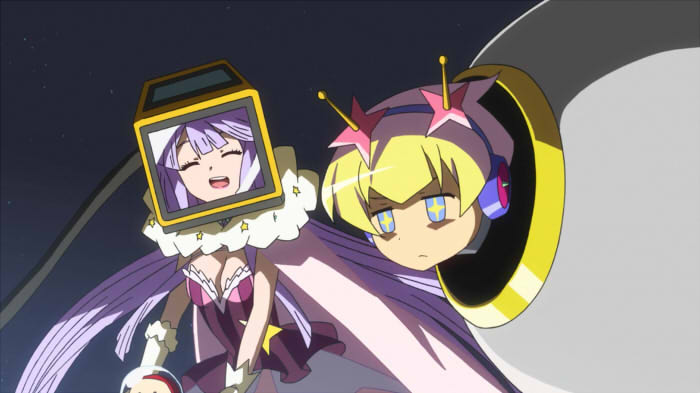
Bringing up Watchmen in any media discussion is usually a foolhardy endeavour, something quite rightly frequently met with an eyeroll as someone once again completely misses the point in both the works being compared, not to mention the fact it’s normally very quickly followed up with the inaccurate use of the term “deconstruction”. It’s usually the sign that a discussion is going into all the wrong places.
In the case of Concrete Revolutio, however, raising Watchmen is almost OK, mostly for the fact that it’s the creative staff themselves who are bringing up such titles as a statement of intent. Much of Concrete Revolutio comes out of a place of frustration of there not really being many works in the anime medium that explore the characters and heroes of a particular era against the society and the political environment into which they were born. Maybe this isn’t really all that surprising, bearing in mind what just recently happened to the first episode of Mr. Osomatsu for treading a little too closely in parody to a number of popular shows – treading acceptably close to characters in reference is a trickier tightrope to walk in Japan than it arguably is abroad, and making a show which relies an awful lot in creating characters who are infinitely close to specific characters (possibly in composite) must be something of a legal headache.
Explaining how Concrete Revolutio starts is a little tricky. Fundamentally, much of this first series is set in an alternate-universe version of 1960’s Japan, using it’s own “Shinka Era” calendar to somewhat confuse matters. The actual start of the show starts with a waitress reading boys comics in fake-1966, who is promptly propositioned by a customer in dark-glasses claiming to really need her help, only for it to suddenly cut to fake-1972 as the same girl is attempting, with little success, to catch the same glasses-wielding fellow from earlier. This is pretty much the way the show continues onwards – whilst most episodes of this first cour of the show focus primarily on the 60’s-era, it frequently flash-forwards to scenes filling in or suggesting small details about something happening in 1969 that changes the worlds status quo.
As for what the status quo is, well, the aforementioned waitress, Kikko Hoshino, is actually a magical girl (or, in her own words, a witch), whilst the guy in glasses is Jiro Hitoyoshi, an operative of the Superhuman Bureau, an organisation that endeavours to register and monitor people with superhuman abilities living amongst Japanese society for, apparently, their own good. You see, the world of Concrete Revolutio is one in which most the excesses of 1960s manga exist as real – and I don’t just mean the pop-art use of screentone the shows art direction seems so fond of. Giant Robots, Ninja policemen, talking animals, boy detectives and Yokai are all things that exists within the world of Concrete Revolutio, and are all things the Superhuman Bureau engage themselves with.
Initially, Jiro is after Kikko’s assistance in dealing with an illicit deal which is about to go down in the cafe in which she was working, though this ultimately ends up evolving into a caper surrounding an Ultraman-analogue and Kikko joining the Superhuman Bureau herself, having become smitten with Jiro.
As things continue, Kikko, along with the rest of the Superhuman Bureau gang, go through a series of seemingly episodic escapades as we slowly move towards that 1969 pivot point, as the cast slowly come to realise things aren’t as clear-cut as they seem, as we see how their actions in the 60’s echo across time. The Friend-To-All-Children ghost-boy Fuurouta is forced to face the fact that actions he thought were clear-cut were actually very much gray, enigmatic Super-Scientist Jaguar literally has to face his own past, whilst robot Detective Shiba has to come to terms with his justice becoming not what he initially thought it was. Unsurprisingly, the Superhuman Bureau itself may not be all it seemed at first glance, and it’s leaders motivations perhaps not as clear-cut as they purport.
Running across both the background and foreground to this, a number of actual real-world events analogues are showing their impact in the fictional world. The Beatles playing the Budokai in 1966 is actually a significant event in one episode, whilst the student protests over Japan-US military treaties that rumbled throughout that decade are constantly showing their impact in the show. The show very much tries to marry these events to the fictional characters they portray within the episodes with which they overlap in interesting ways. It’s hard to miss that the two-parter involving the protest-movement enlisting a giant monster not only overlaps with the era where Godzilla-alikes were arguably at their peak, but also specifically with Son of Godzilla and the effective top-of-the-bell-curve point of Godzilla being an explicit, child-friendly force for good.
Aside from the amusement of trying to figure out exactly what’s being referenced, it’s this kind of play of overlapping the fiction of the era with its politics, emphasizing how they influenced each-other, that makes the show particularly interesting to watch. In many senses, it’s about how the politics of the era turned the optimistic heroes that came about whilst Japan began to recover from the war became the more violent or cynical heroes that followed – that the Gekiga manga movement started to come into it’s own in the late 60s and early 70s with the likes of Golgo 13 and Lone Wolf and Cub is probably something significant, as is the launch of Shonen Jump in 1968.
The thing is, though, whilst Concrete Revolutio is both narratively and thematically extremely dense, it doesn’t often seem that way. The era-jumping is often somewhat disorientating, at least within the initial episodes, but the show often carries a somewhat pulpy, jovial tone to it rather than the somewhat oppressive tone many works in a similar wheelhouse deal in. I mean, the shows Astroboy analogue is a little robot girl who is also the satellite Sputnik, and when the Superhuman Bureau need to talk to her one episode, they send Kikko into orbit with a telephone with a really, really long cable attached to it. It’s a funny show. It’s an exciting show. It’s a genuinely mysterious show, as things weave together to slowly suggest exactly why Jiro parts ways with the superhuman bureau. It’s also often a weirdly poignant show, and is pretty happy to defy your expectations whilst doing it.
Whilst much of the first series was written specifically by the main series composer Sho Aikawa, it’s of curious note that they enlisted Masaki Tsuji is write, rather specifically, an episode about the universes analogue to Sazae-san. Based on a manga starting in the 1940s, the anime version of Sazae-san started in 1969 and is running to this very day (making claims of The Simpsons being long-running somewhat laughable), and is pretty much eternally the most-watched TV anime in Japan, despite it’s obscurity in the English-speaking world. Masaku Tsuji also happened to write the script for the very first episode of the Sazae-san anime. The show’s upcoming second season is throwing Gen Urobuchi and Kazuki Nakashima into the scripting mix as well – I’ve got absolutely no idea what Butcher is going to be doing, but given Nakashima’s background in things like Gurren Lagann, Kill la Kill and Re: Cutie Honey, you have to wonder if he’s been enlisted to tackle Shameless School or Devilman or some other Go Nagai work. Or maybe Kamen Rider, as it’s probably the era for that too! It’s potentially pretty exciting!
(Also, I’ve been reminded that Urobuchi has also written a Kamen Rider show in recent years…)
(Also Also, I want an Earth-chan liquid soap dispenser)
(Also Also Also, the one thing ConRevo feels like it’s missing is it’s equivalent of Watchmens Pirate Comics, but given ConRevo deals in far more than just hero comics, I guess coming up with something like is borderline impossible)
The “People Keep Talking About This†Award for Shows I Need to Watch More Than Five Episodes Of – Yuyushiki
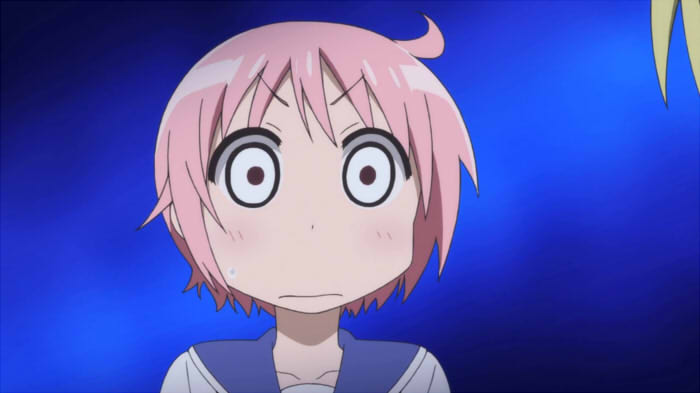
Folks are still talking about this due to the release of a BD boxset for it, whilst I made but one episodes progress this year. Congratulations, me! Probably not going to have it all watched by the time Kizumonogatari comes out at this point, though.
I was going to plonk School-Live (or Gakkou Gurashi, if you will) here, but I ended up ploughing through the rest of the series a few days ago after seeing it pop up in multiple folks Show of the Year-type posts. It’s a bit of an odd one for me, in that I can appreciate what it’s doing, but at the same time, it personally does very little for me. The way they combine the tropes of sitcom/slice-of-life anime with the tropes of Zombie-genre fiction to try and build a sense of connection with the characters is smart. The way they deal with Yuki’s delusions by often showing their hands before actually playing them is smart. The shows first episode is real smart.
Unfortunately, I think I’ve just been exposed to too many genre works over the years, even if it’s not my necessarily my thing. Chalk that up to knowing folks who are really into horror fiction, including a bunch of weird Italian zombie movies and giallo thrillers. It’s a little frustrating, because School-Live is clearly better made and constructed than most works of the genre (and I’d generally trust anyone from Nitro+ to know that particular genre well enough to write something smart and genre-savvy), but the experience of me watching it was little but seeing a series of strings being pulled. A series of “OK, that was kind of smart” moments acknowledging what they were doing without any of the actual intended impact behind them.
Which kind of sucked for me, I suppose.
(Also, apparently it was wrong of me to tarnish Aria AA with the brush of that other Aria the Scarlet Ammo show, as apparently it was pretty entertaining. Maybe I’ll check that one out somewhere along the line)
(Also, Also, maybe I’ll actually finish that boob-ribbon show at some point. It’s hard to properly communicate exactly how much that first novel grated my nerves in the ways that only a light novel can, but what I saw of the anime softened some of those most-annoying edges an awful lot. Also, I hear the Minotaur fight is pretty good!)
The “Crikey, I bet that took someone some time” Award for Most ANIMATION show – One Punch Man
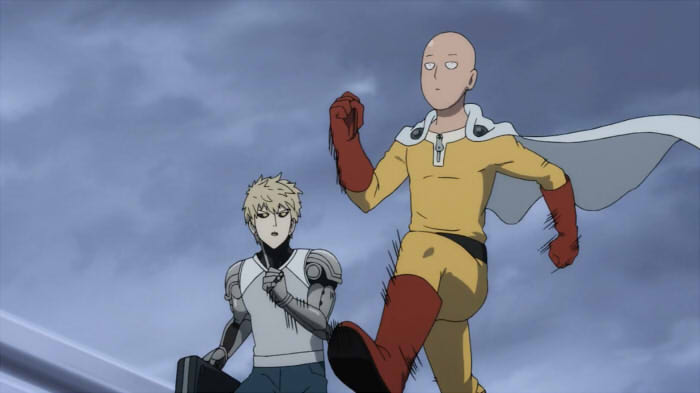
One Punch Man is a very entertaining show. I mean, I don’t like everything about it (Puri-Puri-Prisoner is a rather tired and unfortunate stereotype at this point), but the show made me laugh quite hard, quite frequently.
As arguably, from a Westerners point of view, the most populist anime of the year (certainly, those ANN poll results would back that impression up), there’s been something of a minor backlash against it in recent days, as folks attempt to solidify their feelings on the last years worth of anime. Largely, they tend to boil down to the show being a big piece of well-produced fluff, “full of sound and fury, signifying nothing”, as it were.
Which is a hell of a dismissive standpoint to have, honestly. Aside from the fact that it’s incredibly difficult to just make a show that’s incredibly entertaining for entertainments sake, it makes the assumption that One Punch Man is a show that nobody else takes anything larger from, just because it doesn’t wear it’s subtext as context. A show doesn’t need to explicitly state what it’s about for it to be about something.
Which isn’t to say that this isn’t a terminal case of reading way too much into something, but as an old-fart, I tend to think it has an awful lot to say about modern working life. The tedium of becoming overly proficient at your job, the futility of having to do something about something you have no chance of dealing with, the reality of the fact that someone is probably taking credit for your efforts without you even knowing it.. it might not speak to you, but, hey, it speaks to me, dammit!
Although, even ignoring that, there’s a lot to be said for healing anime, you know, and there’s a certain kind of catharsis that comes from seeing a guy step-up and explode a giant fishman with a single punch that isn’t actually that dissimilar to seeing Renge-chon trying to learn to ride her bicycle, right? Admittedly, it’s pretty much the same kind of satisfaction you get from seeing a shuttle-surfing magical girl punch through a mountain, but there’s only so much new Symphogear in one year.
(Also, I have a lot of time for anything with a JAM Project OP. JAM Pro where great at Lantis Vegas, and I really need to find the opportunity to see them again at some point, but then I say that a lot whilst being proactive about nothing)
The “CRIKEY, I bet that really took someone some time” Award for Actual Most ANIMATION show – Sound! Euphonium
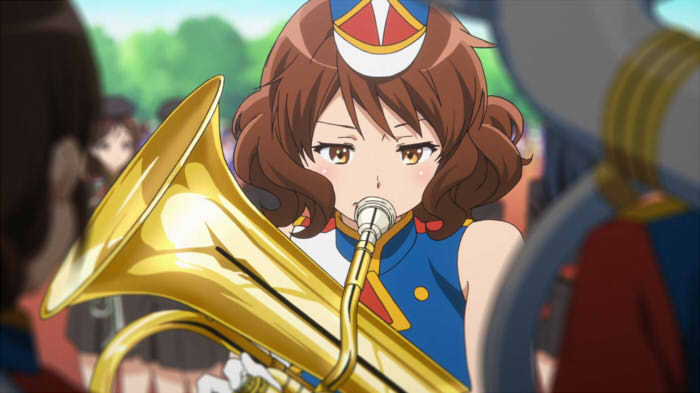
I don’t have a whole lot of say about Sound! Euphonium, not least because there are far smarter folks than myself spouting many, many more refined words about it all over the internet at the moment. Also, totally not a band kinda guy, so I’m probably missing something about how accurately it apparently recreates that particular experience there.
What I will say is that, in many ways, it makes a lot of really difficult things seem really rather effortless. There’s a lot of things in the show that could have come across as being annoyingly cloying if taken just a single step further that are instead instantly likeable, and they sell it’s characters well enough that it’s easy to buy-in to whatever minor drama is occurring.
Also, the animation, whilst not as obviously flashy as a robot detective battling faux-Kikaider, or a bored superhero slugging it out against an army of ill-tempered denizens of the underground, is staggeringly impressive. Instruments, not least Brass ones, are not easy to draw – they have a lot of very specific lines that have to wrap around on themselves in very specific ways. They don’t lend themselves to be drawn loosely, else something simply won’t match up somewhere. With Euphonium, they were done by hand, and not just the outlines – all that complicated, reflective shading on them way laid out on the keyframes. If you ever get to look at one of the replicas up close, it’s pretty astonishing to see, and the sheer amount of effort that went into something like the concert scene in the last episode is mind-boggling even before you also consider they went to the effort of making sure everyone was actually playing the instruments correctly. There may be something staggering about the expression what goes into something like a fight scene in One Punch Man, but there’s nothing any less impressive about the sheer skill and effort involved in Euphoniums clutch moments.
All of which sounds a little dismissive about the shows wonderful character animation, but whilst there’s a certain seductiveness to Kumiko and Reina’s physical interactions, that’s rather more difficult to talk about, you know? They aren’t always working with material that I’d personally consider stellar, but KyoAni are generally way too good at what they do, and when they’re working with great material like in Hyouka and Euphonium, well, you get something pretty magical.
(Also, they played Yellow Magic Orchestra’s Rydeen, and that’s a great record. I’m told it was a Beatles number in the original work, but, whatever).
(Also Also, if I was to pick fault with the show, I don’t think that the OP did the show many favours in terms of ditching the entirely inaccurate “K-On with Trumpets” image the show struggled to shake amongst those who didn’t really watch it)
(Also Also Also, Sapphires goofy skip in the ending credits totally wouldn’t allow her to keep pace with the other girls in reality)
The “Do People Still Actually Use The Term Gainax Ending?†Award for Seriously? WTF!? – Aldnoah.Zero 2
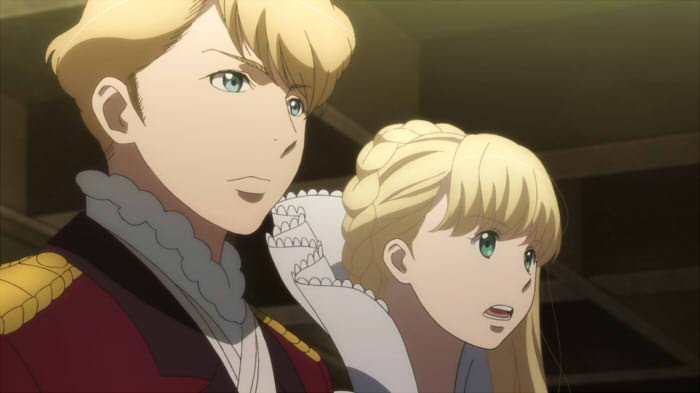
I suppose the first half of Aldnoah should really have set me up for something of an… interesting ending, but whilst certainly not exactly what you’d call traditional, the conclusion pretty much went over with the same kind of enthusiasm which accompanies a wet fart.
I spilt a lot of words about how the first series panned out last year, but to reiterate, Aldnoah is a scifi Robot show in which the nobility of the Martian colonies invade Earth following the staged assassination of their princess, Asseylum, who was visiting Earth as a peace envoy. Now, Asseylum didn’t actually die, rather her body-double did, and instead she ended up with the students of a military academy, on the run herself from the invading Martian forces having discovered the assassins were from her own side. There she meets Inaho, the presumably autistic-genius Earth pilot who manages to scheme and plot his way through defeating far superior Martian hardware, whilst her childhood friend Slaine (originally from Earth) remains in the Martian ranks.
The first series ends with Inaho and Asseylum leading an assault against a Martian stronghold, where Asseylum ends up being shot by the man behind her assassination plot, whilst Slaine just ends up shooting Inaho point-blank in the head, just because.
So, that’s where we left off at the end of last year – Inaho presumably dead, Asseylum presumably dead, and Slaine apparently completely missing. Of course, no-one is actually dead – Slaine cuts a deal the critically-injured Count behind the plot against Asseylum to improve his standing within the Martian nobility, and sticks the comatose Asseylum in a medical facility. He then also shacks up with Asseylums hither-to unmentioned sibling Lemrina, who, rather infatuated with Slaine, goes along with his plans to change Martian society from the inside by posing as her sister.
Inaho, of course, isn’t dead either, but he does now have a gnarly robot eye, and being Inaho, almost immediately realises that the Asseylum he is seeing in the Martian broadcasts isn’t actually Asseylum, but, hey, it’s time to get to the frontline and fight some stuff!
The show from there is actually moderately entertaining – I mean, as much as everyone else seems to be somehwat fed-up with it at this point, I do continue to rather enjoy Sawano’s particular brand of vocal-laden bombast with the music, and that does an awful lot to sell the things going on. The show does deliver a bunch of satisfying moments in that Death Note-y, Code Geass-y fashion, if often on a small-scale, as the machinisms we see Slaine lay-out come to fruition, or as Inaho punks an opponent he probably has no real business beating.
Of course, Asseylum does eventually wake up, and through a combination of things, that eventually leads to Slaine downfall as things outside his reach ultimately conspire against him. The Earth forces plot to attack the Martians main Moon stronghold in order to kill Asseylum and bring disorder to the Martian forces, which leads Inaho to attempt to directly intervene, leading to his and Asseylums one-and-only, extremely brief, meeting of the whole series (which is actually mostly handled by Inaho’s robotic eye controlling the rest of his body)
All of this is an awful lot of convoluted set-up for what eventually happens. At the very end of episode nine, we are introduced to a new character, Klancain, another Martian noble. He assists in saving Asseylum, and promptly manages to get himself engaged to her so that she can declare herself the new Empress of Mars and call a cease to the hostilities against Earth.
Of course, that’s not the actual end to the series, as things continue on to the inevitable battle between Inaho and Slaine that has no longer has any meaning beyond the fact that these two fellows who have barely personally met kind of don’t get along with each-other. Neither of them actually die – Slaine ends up being the scapegoat for everything that went on beforehand, and much like Magneto in those X-Men movies, ends up locked in a transparent cell doing little but playing the occasional game of chess. Inaho has his robot eye removed, and the time Asseylum spent with either him or Slaine became nothing but a pleasant memory for any of them.
In a sense, it’s a pretty interesting concept for an ending – I mean, war sucks, sacrifices have to be made to end them, and things rarely wrap up in a satisfying way even for those who are technically victorious. The difference here is that they make the sacrifice a purely emotional one – none of the characters you would be expected to have any real investment in actually die, but they all have to sacrifice a certain amount of personal happiness.
The issue is that Slaine spends most of the second series being a jackass it’s hard to feel any sympathy for, whilst Inaho is deliberately flat. You have no real investment in either of them by the time you get to the end of the series, and aside from the whole emotional impact being completely deflated by that, it means that the fact that the war is already over by the time Inaho and Slaine go at robs that of any actual consequence, which would be fine if we had any interest in the characters. Which we didn’t.
What makes this more disappointing is that the second series rather doubled-down on Inaho and Slaine as the heart of the series. Pretty much everything they did with the arguably more interesting characters like Rayet, daughter of the leader of the original assassins of Asseylum, or Marito, the PTSD-suffering training instructor, was sidelined to the point of relative insignificance.
Maybe disappointment is the real word to be using here, though, because man, Aldnoah had an awful lot of good ideas that it ultimately did little satisfying with, and now I’m just getting depressed thinking about it.
(Also, speaking of disappointments, oh boy, Empire of Corpses. That really has a WTF ending, but given how few have likely had a chance to see that as yet, I’ll hold my tongue on it…)
The “How to Buy Action Figure Man†Memorial Award for Services to Toyetic Industries – Gundam Build Fighters Try
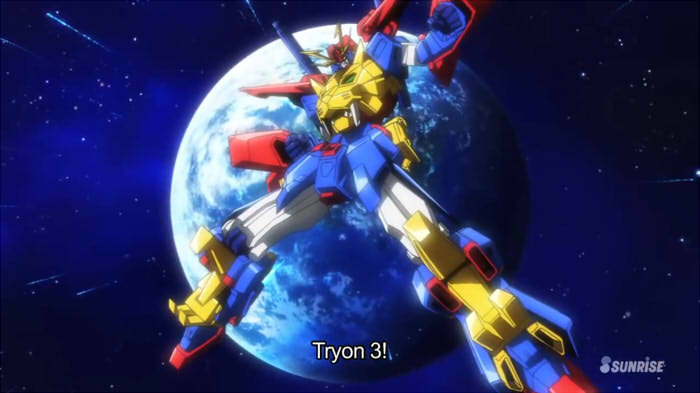
Or, the Tryon 3 award for putting a combining super-robot into a Gundam show, although I’ve not got around to building the HGBF kit I have sitting in the corner (alongside a Beargguy-F, obviously).
That Build Fighters Try tends to get a lot of flack thrown in it’s direction is probably more representative of how much people respect the original Build Fighters than it necessarily is of the quality of the show itself. Much of Build Fighters Try is fine, occasionally terrific, but it rarely, if ever, hits the highs of the first series.
Part of that probably comes down to the fact that the staff actually remembered to make a kids show in order to sell toys to kids this time, rather than stuffing their show full of adults. Ricardo Fellini may have been awesome, but it’s tough to see how they might have sold that to kids. More than that, though, people tend to get a little annoyed with Sekai’s romantic problems (even if he is largely oblivious to them himself).
That later point is maybe a little emblematic with the problem with Try, in a roundabout way. Whilst the original Build fighters was predominantly about one-on-one robot battles, Build Fighters Try shifts the format to a three-on-three format. This isn’t so much of a problem at the beginning of the show, when they were trying to build up the shows protagonists, and we tended to see the same characters frequently. The issue gets to be as soon as we start to get to the main tournament in the back-half of the show – as soon as you introduce a tournament, you have to come up with a bunch of opponents for everyone to take on, and because everyone is playing in groups of three, well, that means you’ve got three times the number of characters you need to introduce.
The show really struggles to find something to do with all those characters, and, unfortunately, that also ends up impacting on the characters that they do have a purpose for. There’s only so much screentime, afterall, and we end up with a bunch of really shallow and transparent characters being set-up just so that one of the protagonists have some kind of buy-in to the battle in question, but without any real gravitas of their own. The battle between Celestial Sphere and Lucas Nemesis in Try has nothing like the weight behind it as something like Aila versus Fellini in the original, mainly because it’s hard to particularly give a damn about Lucas (or even Wilfred, for that matter.)
This isn’t to say that the show doesn’t have good characters, but most of those are the ones who appear in the shows first half, but whilst the original Build Fighters managed to continue to find relevant things for it’s cast to do as the show continued, Try struggled to do so in a meaningful way. Not only that, but everyone they do try to bring meaning to tends to have their meaning being boiled down to having some kind of rivalry with the protagonists. Even when friends or rivals with Sei or Reiji, most of the characters in the original Build Fighters tended to have their own, completely-separate things going on in a way that those in Try simply don’t.
But, hey, saying a show isn’t as good as the original Gundam Build Fighters is hardly an insult – there’s not many shows out there which are as flat-out entertaining as Build Fighters managed to be, and Try still managed to have it’s moments that made it more than worth checking out.
(Also, Gyanko was great)
(Also also, yeah, kind of fell off G-Reco after a point. I do sort-of want to revisit that show, as I don’t think it’s completely devoid of any redeeming features as some tend to imply, but it’s a little hard to build up the motivation right now)
(Also also also, not bought any Iron Blooded Orphans kits yet, but I was looking at a nice Barbatos the other day…)
The “Actual Favourite Show Of The Year” Award for Show I Actually Liked – Shirobako
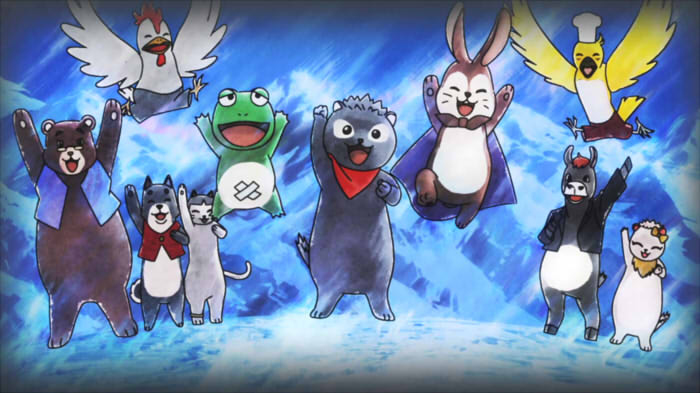
Probably not really that much of a surprise that a nerd who writes about liking cartoons as a hobby likes a show about the art of making cartoons.
I genuinely don’t have much to say about Shirobako, though. Idealised in many ways that it is, Shirobako was about the most I got involved in an anime drama this year – I laughed, I cried, I got an incredible sense of catharsis as the director finally swatted aside that pesky light-novel editor. It’s a terrific show, and I really don’t get where those folks who think it’s without a genuine heart or soul are coming from.
(Also, really dug the Exodus OAV. I’d totally watch an entire series of that, which makes it a shame that such a thing will never happen)
(Also Also, this years actual best show was Old Episodes of Ojamajo Doremi. That show operates on whole other level, and one which has all the faces)
The “Realist Anime” Award for the Anime That Was Actually Most Real – Hackadoll the Animation
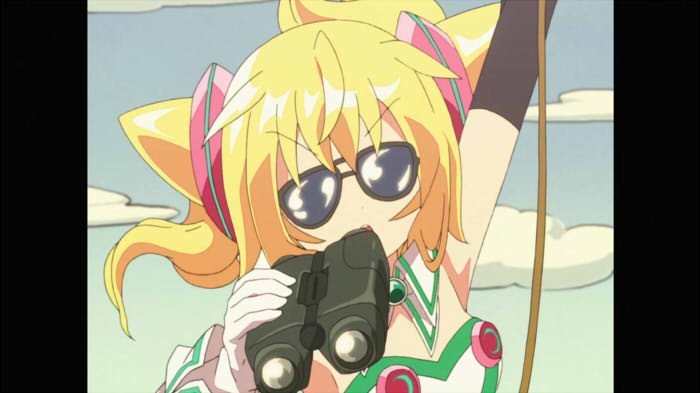
Mostly, admittedly, for the Kurobako episode that is parodying Shirobako (by way of Gunbuster). Given the lead-times that can be involved in making anime, it’s a pretty impressive turn-around, not to mention a sign that Shirobako has clearly made it.
Still, it’s not the only REAL episode of the show, nor the only episode that manages to parody or reference something of surprising recency – the final episodes equating Comiket to a hybrid of Mad Max and Fist of the Northstar was pretty hilarious, after all. As was the episode about the idol fanboy – or the episode in which the Hackadolls become idols for that matter.
Hackadoll wasn’t the best short anime of the year – unfortunately for it, the currently omni-present Teekyu conquers all with it’s gag content as dense as a blackhole – but for a cartoon based on a mobile phone news aggregation application, it well overachieves.
(Also, whilst we’re talking about WUG-related matters, Wake Up Girls ZOO was a pretty real show as well. Major props to it for mocking the show it span-off from, even whilst they had a pair of sequel movies in production)
The “Why Did You Have To Do That?†Award for Really Dumb Thing in an Otherwise Entertaining Show – Charlotte
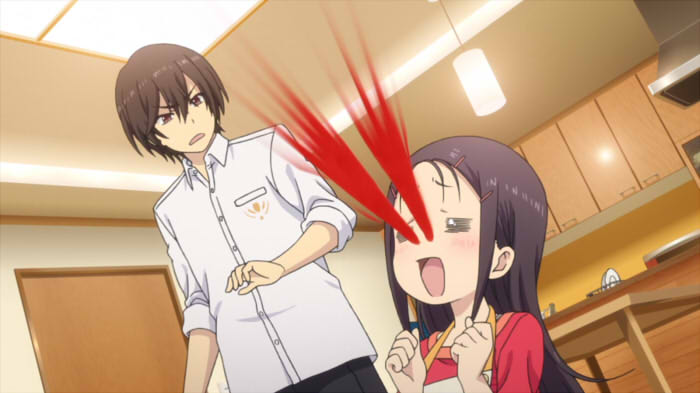
This isn’t really in the spirit of the original use of the category, which was all about the rather unfortunate event that besmirched the first series of Valvrave, but Charlotte did end up rather annoying me, even if it wasn’t a matter of it introducing a rather problematic event.
So, Charlotte is a show about a jackass high-school student, Yuu, who has the ability to take over someone else’s body for a short period of time, which he uses to try establish an image of superiority by cheating and scheming his way through life by abusing said power. Yuu is pretty shortly collared by Nao, a short-tempered lass from another school with the ability to obscure herself from being seen by one person at a time, who forces him to transfer to the school at which she is the student president. There, she forces him to assist with her work of tracking down other students with special powers in order to insist that they stop using them.
To get into the spoiler talk, partway through the show, Yuu’s beloved younger sister (voiced by AnimeIdolTwitters object of obsession Mocho – that is, Momo Asakura) dies – it turns out that she has a power too, one which rather involves making buildings collapse, in this case with her still inside it. This drives Yuu into a horrific, self-abusive depression that Nao only narrowly manages to drag him out of before he goes too far.
That last thing is only really relevant for one episode, and is the part of the show a lot of people tend to have a problem with – it’s all a little over-the-top, but it’s brevity robs it of some of the weight it should probably carry. It’s one of the larger issues with the show – it’s trying to do a lot with the number of episodes they have, but a lot of what happens is too truncated to really carry the impact the show probably thinks it’s having.
Yuu’s spiral into self-hurt isn’t really what I have the problem with, though – it’s what comes afterwards. It turns out that Yuu also has an older brother. Yuu’s memories of him had been erased by a power-user with the ability to do that, whilst the older brother was off trying to secretly build a secret organisation to protect power-users from those who wish to experiment on them.
It’s the way that Yuu’s brother has built this organisation that rather bugs me – he’s a time-leaper, in that he can jump-back along his own personal time-line, and he’s used this power in order to iterate and iterate on the same process over again, correcting his errors each time.
The problem with this is, at this point, it’s become an incredibly tired anime cliche. We’ve all seen Madoka, and most of us have probably seen Steins;Gate. Some of us probably watched PunchLine this year as well, and that wasn’t the first time that particular creator used a variation of the trope either. It’s not difficult to point out other examples either – probably because of the nature of the medium, the use of repetition as a theme is a pretty common theme amongst many famous visual novels.
Essentially, at this point, it just comes across as lazy and hacky writing. It’s a cheap way to imply despair, and to add weight to a situation – it’s taken this long to get to a world-line where they managed to be this successful, but they still have other issues. Suddenly throw the characters into a situation where that power can no longer be used and, well, instant tension. At the same time, though, as soon as such a power is mentioned, you can probably make a pretty good guess as to where things are going to go, and in the case of Charlotte, they don’t really throw any spanners into what were predictable works.
In a show with a bunch of genuinely more unusual ideas that it has little time to explore, it just ends up like a cheap waste of a time that actively dulls the preceding events in the process. It’s the point that the show lost me.
(Also, the nose-bleed face for younger sister Nendoroid is pretty spectacularly great)
The “I Promise This Is The End†Award for Show I Seemed To Like More Than Others – Classroom Crisis
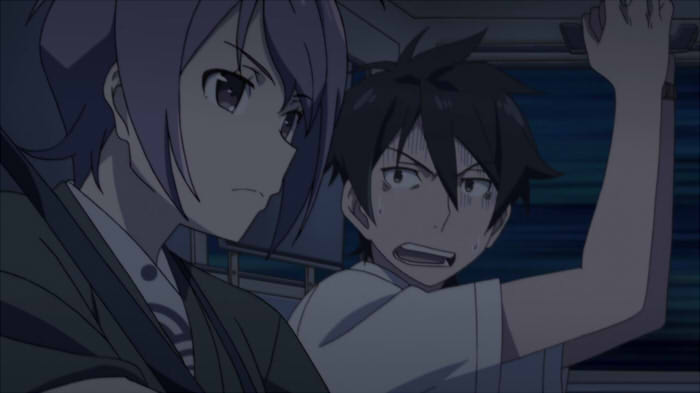
I enjoy the way this show looks.
Honestly, shallow as that sounds, that pretty much boils down to the reason I like the show – there’s something about the character design that I find curiously attractive, and that was pretty much enough to keep me watching the show even if it wasn’t always the greatest thing. I mean, as a show, it’s actually fine. It’s not super-great or anything, and it leaves enough loose-ends lying around at it’s conclusion for it to be a smidgen frustrating, and it completely squanders most it’s cast in a way that makes you think it’s a truncated version of something else which doesn’t actually exist, but it’s entertaining enough for the most part.
Fundamentally, Classroom Crisis is a bit of a lightweight “Magnificent Bastard” kind of show – it’s the kind of show which primarily deals in people trying to come up with elaborate schemes to try and screw each-other over, or to at least put-across the idea that they might have something in the works in order to motivate someone else to work harder at what they’re supposed to be doing. The universe of those show is one in which even students are essentially salaried employees of the companies they are likely destined to work for. The show centres around A-Tec, the once-prestigious elite class funded by a major engineering company, which, having fallen behind the absolute cutting-edge they were once on, has lost something of it’s shine. The arguable protagonist of the show, Nagisa, is brought in to gracefully shutter A-Tec now that they are a net-negative, rather than positive, for the companies earnings. Nagisa, despite being a mid-tier manager at the company well-known for managing to get the job done, is actually the same age as the rest of the A-Tec students he suddenly integrates himself into the class of despite the fact that’s he’s angling to shut them down.
It also turns out, however, that Nagisa has something mysterious in his past which leads him to have something against the organisation that he works for, and particularly his siblings who work in it’s higher management. The question gets to be whether Nagisa is actually aiming to close down A-Tec, or if everything he is doing is actually moving towards the aim of being able to more successfully wield them as a corporate weapon against his brothers. The answer is, of course, probably obvious, particularly given that he finds it increasingly difficult not to let the bunch of loveable doofuses he finds himself working with ingratiate themselves with him.
Also, he has a ninja for a secretary.
The general issue with the show gets to be that, well, A-Tec is supposed to be an entire class of people, but the only thing which generally reminds you that there’s more than four or five characters is that they sporadically need to fill seats at significant events. The show fairly frequently goes through the motions of setting itself up as an ensemble piece, but it rarely actually nails it. If the show had dropped any kind of pretext regarding that, things would probably go down much more smoothly, but the nature of the show necessitates having characters with skills that it’s otherwise significants don’t possess. They’re needed, but not enough that the show deems it necessary to give anything about them move than but a shallow skimming, and that just ends up being a little on the frustrating side. It’s this kind of show that is generally the victim of anime shows, particularly completely original ones, only getting the twelve or thirteen episodes to do their business, as it’s hard to spare episodes to give characters their due when you have more of them than there are episodes.
But, still, the girls are cute.
(Also, I like the OP)
(Also Also, my Love Live movie BD turned up today. Maybe I’ll get around to writing about it, maybe I won’t)
